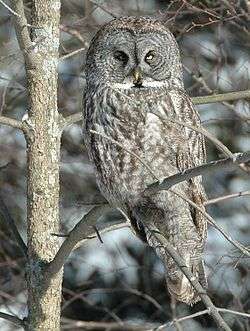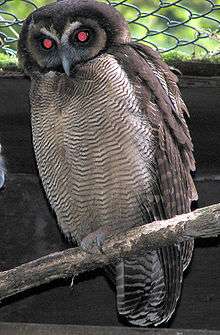''Strix'' (genus)
| Strix owls Temporal range: Early Miocene to recent | |
|---|---|
 | |
| Great grey owl, Strix nebulosa | |
| Scientific classification | |
| Kingdom: | Animalia |
| Phylum: | Chordata |
| Class: | Aves |
| Order: | Strigiformes |
| Family: | Strigidae |
| Genus: | Strix Linnaeus, 1758 |
| Species | |
|
Some 15, see text. | |
| Synonyms | |
|
Ptynx Blyth, 1840 | |
Strix is a genus of owls in the typical owl family (Strigidae), one of the two generally accepted living families of owls, with the other being the barn-owl (Tytonidae). Common names are earless owls or wood owls, though they are not the only owls without ear tufts, and "wood owl" is also used as a more generic name for forest-living owls. Neotropical birds in the genus Ciccaba are sometimes included in Strix.
These are medium-sized to largish, robustly built, and powerful owls. They do not have ear tufts and most are highly nocturnal woodland birds. Most live on small mammals, birds, and reptiles.
Most owls in the genus Strix vocalise through hooting and lack visible ears - this is how they are distinguished from other genera of owls.
The Latin genus name Strix referred to a legendary, vampiric owl-monster believed to suck the blood of infants.[1] Although the genus Strix was established for the earless owls by Linnaeus in 1758, until the late 19th century, many authors applied it to other owls – namely the Tyto barn-owls.[2]
Species in taxonomic order
- Spotted wood owl, S. seloputo
- Mottled wood owl, S. ocellata
- Brown wood owl, S. leptogrammica
- Bartels's wood owl or Javan wood owl, S. (leptogrammica) bartelsi
- Himalayan wood owl, S. (leptogrammica) newarensis
- Tawny owl, S. aluco
- Himalayan owl, S. nivicolum
- Omani owl, S. butleri[3]
- Desert owl, S. hadorami [3][4]

- Spotted owl, S. occidentalis
- Northern spotted owl, S. o. caurina
- California spotted owl, S. o. occidentalis
- Barred owl, S. varia
- Cinereous owl, S. sartorii
- Fulvous owl, S. fulvescens
- Rusty-barred owl, S. hylophila
- Rufous-legged owl, S. rufipes
- Chaco owl, S. chacoensis
- Ural owl, S. uralensis
- Père David's owl, S. davidi
- Great grey owl, S. nebulosa
- African wood owl, S. woodfordii
The following are sometimes included in the genus Ciccaba.
- Mottled owl, Strix virgata
- Black-and-white owl, Strix nigrolineata
- Black-banded owl, Strix huhula
- Rufous-banded owl, Strix albitarsis
Fossil species
The genus Strix is well represented in the fossil record.[2] Being a fairly generic type of strigid owl, they were probably the first truly modern Strigidae to evolve. However, whether several of the species usually placed in this genus indeed belong here is uncertain.
Generally accepted in Strix are:
- S. dakota (Early Miocene of South Dakota, USA) – tentatively placed here
- Strix sp. (Late Miocene of Nebraska, USA)
- Strix sp. (Late Pliocene of Rębielice Królewski, Poland) apparently similar to the great grey owl[2]
- Strix intermedia (Early - Middle Pleistocene of EC Europe) – may be paleosubspecies of S. aluco
- Strix brea (Late Pleistocene of SW North America)
- Strix sp. (Late Pleistocene of Ladds, USA)
"Strix" wintershofensis (Early/Middle Miocene of Wintershof West, Germany) and "Strix" edwardsi (Middle Miocene of Grive-Saint-Alban, France), while being strigid owls, have not at present been reliably identified to genus; they might also belong into the European Ninox-like group.
"Strix" ignota (Middle Miocene of Sansan, France) is sometimes erroneously considered a nomen nudum, but this assumption is based on what appears to be a lapsus or misprint in a 1912 source.[5] It may well belong into the present genus, but this requires confirmation.[2]
"Strix" perpasta (Late Miocene – Early Pliocene of Gargano Peninsula, Italy) does not appear to belong into this genus either.[6] It is sometimes considered a junior synonym of a brown fish-owl paleosubspecies.[2]
UMMP V31030, a coracoid from Late Pliocene Rexroad Formation deposits of Kansas (USA), cannot be conclusively assigned to either the present genus or Bubo.[7]
Extinct forms formerly in Strix:
- "Strix" antiqua – now in Prosybris
- "Strix" brea - now Oraristrix brea
- "Strix" brevis – now in Intutula
- "Strix" collongensis – now in Alasio
- "Strix" melitensis and "Strix" sanctialbani – now in Tyto
- "Strix" murivora – male of the Rodrigues owl
- "Strix" newtoni and "Strix" sauzieri – male and female of the Mauritius owl
References
- ↑ Jobling, James A (2010). The Helm Dictionary of Scientific Bird Names. London: Christopher Helm. p. 368. ISBN 978-1-4081-2501-4.
- 1 2 3 4 5 Mlíkovský, Jirí (2002): Cenozoic Birds of the World, Part 1: Europe. Ninox Press, Prague. p.217
- 1 2 "Owl discovered in 2013 named Omani Owl". Times of Oman. 5 October 2015. Retrieved 7 October 2015.
- ↑ Desert Tawny Owl: New Species of Bird Discovered
- ↑ Paris (1912: p.287) referred to Milne-Edwards (1869–1871: p.499) as the taxonomic authority, but the cited page only describes this owl but does not assign a specific name. However, the name Strix ignota is given on p.580 of Milne-Edwards's work referring unequivocally to the fossils described on page 499.
- ↑ Olson, Storrs L. (1985): Section IX.C. Strigiformes. In: Farner, D. S.; King, J. R. & Parkes, Kenneth C. (eds.): Avian Biology 8: 129–132. Academic Press, New York. p.131
- ↑ Feduccia, J. Alan; Ford, Norman L. (1970). "Some birds of prey from the Upper Pliocene of Kansas" (PDF). The Auk. 87 (4): 795–797. doi:10.2307/4083714. JSTOR 4083714.
Further reading
| Wikimedia Commons has media related to Strix. |
- Milne-Edwards, Alphonse (1869–1871): Recherches anatomiques et paléontologiques pour servir à l'histoire des oiseaux fossiles de la France (Vol. 2). G. Masson, Paris.
- Paris, P. (1912). "Oiseaux fossiles de France". Revue Française d'Ornithologie. 37: 283–298.